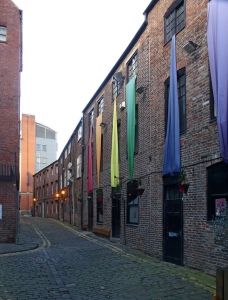
John Dawson is a key figure and touchstone for this project, as its title comes from his testimony to the 1833 Factories Inquiry Commission:
I was set to spinning and doing jobs; any work that wanted doing.
John was in his 20s when he went before the commissioners in Leeds. He was no longer working in a textile mill, but he recalled that he had done this for many years, as a child and a youth.
I was between six and seven when I first began to work in Shaw and Tennant’s flax-mill in Leeds as a doffer …
The mills caused him to become disabled, his knees were affected significantly so that, years later, he still had great difficulty walking. Despite pain and deformity developing in his legs, he continued to work: “I was obliged to do it or go” (lose his job). As well as a doffer, removing full bobbins from the spinning machines, John also hugged bobbins, carrying full bobbins from room to room, making sure the thread didn’t unspool from them.
There would be sometimes two bobbin-huggers in a room, sometimes one: I was the only one in my room, which contained about sixteen sides and about half-a-dozen doffers…
I stopped at it two or three years: the pain and weakness growing worse all that time, and deformity evidently coming on: my father and mother both observed it: they did not make any application to the over-looker, or to the master, nor did I myself: I did not think so much about it then as I do now…
My knees were quite bent at that time, as bad as ever they have been: I did not see any doctor about ’em until after we left Clayton’s. We staid there between three or four years.
Dr Loudon’s report to the commission, based on his examination of John, confirmed the evidence:
JOHN DAWSON, aged twenty-eight, born at Leeds. Began between six and seven years of age to work in a factory. Worked from six to seven at first. Had only forty minutes for dinner. Between nine and ten years of age felt a weakness and pain in his limbs, and they began to bend. They took four or five years to be as crooked as they are at present. He then worked from five to nine.
This person is a thin delicate man. His ancles and knees are swollen and deformed in the same way as the preceding witness. I have no doubt the direct cause of the crooked state of his limbs was the long hours and standing attitude he had to undergo. He is at present a tailor.
Leeds author Chris Nickson was inspired and moved by John Dawson’s testimony. He paraphrased the evidence from the Factories Commission and added authentic, believable details in The Factory Lad’s Testimony. This makes John’s story even more relatable.
John stayed a tailor for at least several years after 1833. In the 1841 census, John Dawson, 35 years old, was recorded as a clothier, another name for a tailor. He lived in Blayds Yard, Briggate, with his wife Hannah, 30, and four children aged between 2-10 years.
Blayds Yard still exists, off Lower Briggate in what is now the Gay Quarter of Leeds city centre. Blayd’s Bar occupies part of the yard. This narrow street has a number of listed buildings, which were shops, workshops and living quarters, from the 18th and 19th centuries. One row of buildings forms an important surviving example of the type of housing built for textile workers within the centre of Leeds in the late 18th / early 19th centuries, in the rear yard of an 18th century town house. Tall first-floor windows suggest that those rooms were workshops.
Much of the street has now been converted to luxury apartments, as have other surviving yards in this part of Leeds.
It may be that John lived and worked in the same building, which was full of small businesses. There was a druggist’s in the yard, which had been there over 100 years. Although the records do not link that building with a merchant involved in the textile trade it is very likely that as a chemist the owner was involved in the processing side of
textiles, possibly dyeing.

Blayds Yard today.
Creative Commons Licence [Some Rights Reserved] © Copyright Alan Murray-Rust and licensed for reuse under this Creative Commons Licence.
One thought on “John Dawson: life after hugging bobbins”